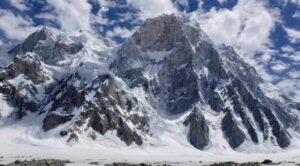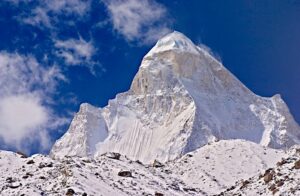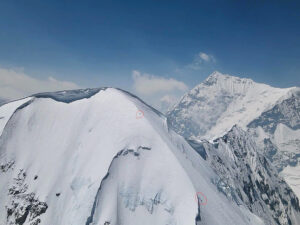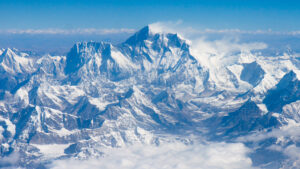Mount Logan (5,959m) is the highest mountain in Canada and the second-highest peak in North America, after Denali (6,194m). This makes it one of the Seven Second Summits, the second-highest peak on each continent.
It is located in the Saint Elias range, within Kluane National Park in southwestern Yukon. Yukon is the westernmost and least populated territory of Canada, with fewer than 40,000 people.

The Saint Elias Mountains. Photo: David Sinson/National Oceanic Atmospheric Administration
Mount Logan
The most striking thing about Mount Logan is its huge mass. The mountain has the largest base circumference of any non-volcanic mountain in the world. You can put Mount Kilimanjaro, the Eiger, and Mont Blanc on its summit plateau, with room left over.

Mount Chitina and Logan Glacier. Photo: Wikimedia
The mountain was named after Canadian geologist William Edmond Logan, founder of the Geological Survey of Canada. Mount Logan’s original height was estimated at around 6,000m. Then in 1992, the Geological Survey of Canada sent climbers to the mountain to measure its exact height via GPS: 5,959m. The mountain continues to grow approximately 0.35mm per year from tectonic uplift.
The climbing season lasts from May to the end of August. The weather at the base of the mountain is usually pretty good. Temperatures hover around 20°C, even on the 2,200m high glaciers that encircle it. But as you climb, the temperature drops rapidly. In winter, it can be -45°C and the average temperature on the mountain is -25°C.

The glacial landscape encircling Mount Logan straddles the Alaskan border. All the background cloud-capped peaks, above, are in Alaska. Photo: Jerry Kobalenko
The weather on the mountain is very volatile, even in summer. From one day to the next, even from one moment to the next, it can suddenly deteriorate, as low-pressure systems sweep in from the nearby Gulf of Alaska. This makes it dangerous for climbers.
In recent years, the rules have changed, and climbers can no longer attempt Mount Logan in winter. Even solo climbs are not allowed. This is because the mountain conforms to the rules of the national park, and in the past, there have been several very difficult rescues of solo climbers. It is worth noting that in Canada, taxpayers pay for rescues, not those rescued.

One of many crevasses on the Logan Glacier, which frames the north side of Mount Logan. Photo: Jerry Kobalenko
Climbing difficulty, Denali vs. Mount Logan
Denali has ferocious Alaskan weather. Denali Base Camp lies at 2,200m on the Kahiltna Glacier. Climbers usually fly in. Technically, Mount Logan is not more difficult to climb than Denali but it is much more isolated. There are no regular flights to the base of the mountain, although an affordable charter airline can fly in climbers on a half-hour Cessna flight.
Some have even towed a sled up the Kaskawulsh Glacier and over the world’s largest non-polar icefield for more than 100km to reach the start of the climb. About 50 years ago, Canadian Rockies legend Don Gardner and his partner skied that route to the base of Mount Logan. They then climbed the mountain and skied out while circumnavigating the mountain. Among other things, Gardner also once shouldered his backpack in Calgary and skied 1,000km to Vancouver.
Both Logan and Denali require good physical preparation, climbing skills, and the strength to ski and hike while carrying all gear in low temperatures. Knowledge of how to act in avalanches and around crevasses is also important.

The first ascent route on Mount Logan, 1925. Photo: The Discoverblog
The first ascent
A Canadian-American-British expedition first climbed Mount Logan in the summer of 1925. Albert H. MacCarthy, Howard Frederick John Lambart, Allen Carpé, William Wasbrough-Foster, Norman H. Read, and Andy Taylor summited on June 23, 1925, via the very long King’s Trench Route, on the west side of the mountain.
Although the first ascent team had a long, tedious expedition of 65 days, the King’s Trench is still the most common route up Mount Logan. However, the 1925 team suffered greatly from hunger, hallucinations, and frostbite.

The East Ridge of Mount Logan. Photo: Peter Von Gaza
The group’s problem was the very long approach trek. Today, as stated above, most climbers fly onto one of the glaciers to avoid this. The King’s Trench Route is one of the most popular ways up the mountain. Much of it can be skied up. There are no technical sections. It just takes stamina.
At about 4,130m, climbers arrive at the King Col camp. Until this point, you can use sleds to haul equipment. From here, climbers carry backpacks to high camp at 5,080m on the summit plateau. Then, one last push to the top.

Solo climber Natalia Martinez in Camp 2 on Mount Logan. Photo: Icefield Disc
First winter ascent
On March 16, 1987, six Alaskans made the first winter ascent of the mountain. Todd Frankiewicz, Willy Hersman, Steve Koslow, George Rooney, Vernon Tejas, and John Bauman ascended via the King’s Trench Route.
Unfortunately, two years later, two young members of this team died. In summer 1988, an air crash killed Koslow near Talkeetna. In August of that same year, an avalanche on Tincan Mountain buried Frankiewicz.

Natalia Martinez had reached almost 4,000m on Mount Logan when earthquakes forced her to abandon her summit plans. Photo: Canadian Geographic
The East Ridge
The other well-known route is the East Ridge. It is a very different climb. This route involves real climbing and includes what may be the best alpine wall climb in North America. It follows a steep and narrow line for 4,000m vertical metres. Though it is not too technical, it is still a major challenge.
An American team of Don Monk, Gilbert J. Roberts, Kermit Ross, Cecil Oullette, and David A. Collins first opened the East Ridge on July 19, 1957. They also made the first ascent of East Peak.

Some of the crevasses on the glaciers surrounding Mount Logan could swallow a house. Logan, a deceptive 30km away, is visible in the background above the sledder. Photo: Jerry Kobalenko
A solo climb and an earthquake
In the spring of 2017, Natalia Martinez, a strong Argentine mountaineer, attempted a demanding traverse on Mount Logan. She planned to ascend the East Ridge solo to the top, then descend via the King’s Trench Route. Martinez planned for nine days of climbing. She set out on April 22, 2017.

The East Ridge of Mount Logan. Photo: Max Neale
On May 1, 2017, Martinez was in her Camp 5, situated on a hanging glacier at about 3,900m. Separated from the summit plateau by a field of crevasses, she was preparing for a big storm. She had food for 12 days and was equipped to wait out the weather in her tent. But before the storm arrived, two earthquakes hit. Measuring 6.2 and 6.3 on the Richter scale, the epicenter was about 200km from the mountain.

Christian Stangl on Mount Logan. Photo: Christian Stangl
Martinez felt the glacier move under her. When she left the tent, she saw huge serac avalanches around her. A few hours later, another quake followed. Martinez decided to move her camp lower, to a better-protected spot at 3,680m. Later, the strong storm also arrived, with winds of more than 120kph. The temperature plummeted to -20°C.
A helicopter finally rescued Martinez after four days stuck on the mountain.

A distant view of the biggest challenge on Mount Logan, the Hummingbird Ridge, a 1,700m-long knife-edge. Photo: Roy Johnson Jr.
Hummingbird Ridge
The central southern ridge of Mount Logan is the most difficult. The first and only ascent of Hummingbird Ridge was on August 7, 1965, by Richard Long, Allen Steck, James Wilson, John Evans, Franklin Coale, and Paul Bacon.
The team completed this incredibly difficult and dangerous route and made a traverse of Mount Logan. They reached the east summit and the central peak on August 7, 1965. The next day, they did the west peak. The team went expedition-style and needed 35 days to complete the climb. There was a point where no return was possible.

Climbers negotiate the very dangerous Shovel Traverse on the Hummingbird Ridge. Photo: Allen Steck
“We started at around 1,680m, and in the end, you are almost at 6,000m,” recalled Steck. “So it is a big elevation gain. Not only that, the ridge is 9,650m long.”
Spring 1978
Mugs Stump and three friends tried to repeat the Hummingbird Ridge in 1978. After 10 days of climbing, they reached the point where the original team had gained the ridge but they had to retreat.

Looking back over the 900m long Shovel Traverse section of the Hummingbird Ridge. Photo: Allen Steck
The 1987 tragedy
In June 1987, two very good climbers went missing on the ridge. South African Dave Cheesmond and American Catherine Freer disappeared while traversing a section called the Shovel Traverse.
In April 2000, park wardens observed a body along an exposed section of the Hummingbird Ridge. Recovery was not attempted, as the body was not visible during a subsequent reconnaissance. The body was close to where Cheesmond and Freer had placed a fixed line and a tent in 1987. Nobody knows exactly what happened to them, but perhaps it was a cornice failure.
Other accidents
Other climbers have perished on Hummingbird Ridge from avalanches. At least five people have died on this ridge. It remains one of the world’s most committing routes.

Mount Logan. Photo: Sam McKoy






